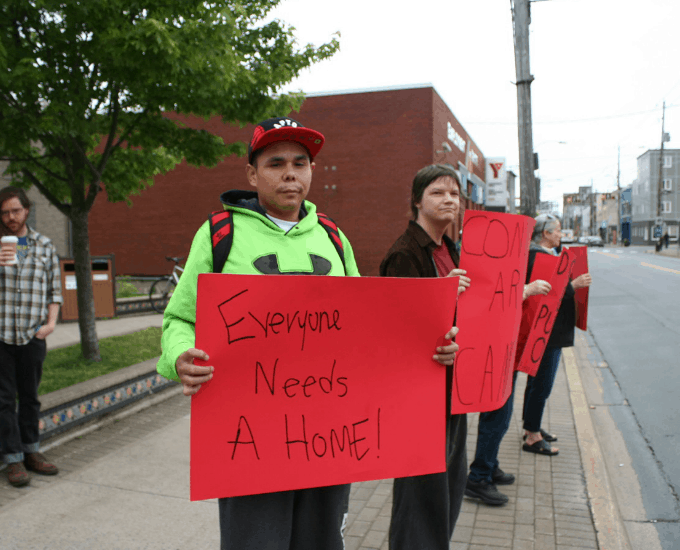
This article was originally published in the Chronicle Herald. It is republished here with the author’s kind permission.
KJIPUKTUK (Halifax) – Housing — what’s happening here in Halifax? From what I can see in my North end neighbourhood, there is a housing crisis … but, at the same time, I can’t walk or drive five minutes without tripping over those huge concrete barriers blocking the streets for construction sites for apartments and condos. There’s construction on Bilby, on Agricola, Gottingen, on the corner of Gladstone and Almon, soon Robie and Quinpool, and an entire new village of more than 500 units on Almon called Richmond Yards. To put that one in perspective, Richmond Yards private housing will have the equivalent of all the public housing units in Mulgrave Park and Uniacke Square.
So, I can speculate maybe 1,000 units are coming soon, delivered by a private developer near you.
So, why are people in tents or mini shelters or even hotels? Because both the federal and provincial governments have been ignoring the huge rise in the need for a housing plan — a plan that is led by public interest and investment, rather than profiteering, in the absence of enough housing stock.
What we hear is that there’s no “affordable” housing. But even that term is super misleading. Affordable means very different things to many people. What’s affordable for anyone making $100,000 is not affordable for most people. The current housing being built is actually affordable for someone, just not most of us.
The problem is that housing is not considered a right, not considered a public necessity to be protected from scarcity and greed. Housing is called a housing market, because it’s driven by the for-profit marketplace. Some people in my demographic are selling their houses (which were affordable for two income employed people 30 years ago) as a substitute for a pension!
The last major housing crisis I can personally remember was in early 1985 when a large Housing for People Coalition was organized in Halifax to protest the non existent vacancy rate — when interest rates were over 11 per cent, no housing was being built, and a garage could be for sale to house you if you could get the mortgage. In the present crisis, there’s currently the appearance of a lot of new construction housing, low interest rates, but prices are out of control, and getting housing is like going to an auction, only for a necessity. Not fun.
In the 1990s, some employed persons could actually afford some housing because there was a pathway to stability. There were then federal and provincial programs like co-operatives (even new construction co-op money — like several built, and still here, on Barrington Street and Brunswick Street, as many as 200 or 300 units), There was rent control in major cities in Canada, such as Montreal, and there were already existing public housing programs from the ’60s. And until the very badly handled de-institutionalization programs, there was actually some shelter, though institutional and very problematic, but at least not a tent, for citizens suffering mental illness.
For the average person in Nova Scotia, those pathways are gone now — retraction of government spending fueled by neoliberal politics. Greed is now king.
So housing is now a so-called free market, which translates as “only for the highest bidder.” If we do the math, on a minimum wage, a person would have to pay almost their entire monthly income for a one-bedroom apartment on the peninsula. Those who are currently left out of the right to shelter include:
- all minimum wage workers
- all precariously employed people (part time, contract, hospitality workers)
- young people with huge student debt
- immigrants not yet employed
- families with more than one child
- Black and Indigenous persons subject to housing racism and discrimination
- seniors on fixed income
And that’s just a part of who’s left out …
Even subsidies to help people on income assistance get shelter, are not actually subsidies for citizens, but subsidies for the landlords — who can keep charging what can be squeezed out of us.
I’m no housing expert or planner, but I think we need our government to keep rent control, to be flooding the market with co-operatives, well-designed public housing, bridge financing for co-housing projects, and a requirement for all new apartment and condos to have a large percentage of set aside units at prices pegged to the minimum wage — and that’s starting now.
We have a shortage, alright, but not just of housing. It’s a shortage of imagination, political will, courage to act and justice.
And a shout out to the citizens who acted to defend the people in shelters and tents last week — who lit a match to get our attention. To quote Langston Hughes: “Nothing lights a fire like a dream deferred.”
Housing should not be a dream, but a right.
Jackie Barkley is a clinical social worker living in Halifax.
Check out our new community calendar!
With a special thanks to our generous donors who make publication of the Nova Scotia Advocate possible.
Subscribe to the Nova Scotia Advocate weekly digest and never miss an article again. It’s free!




Why is it that nobody ever mentions the word accessible when mentioning affordable housing? Accessible housing does not just mean a ramp to get in the front door it means so much more. Many people with disabilities are low income as well, but their specific requirements are never being mentioned along with the word affordable